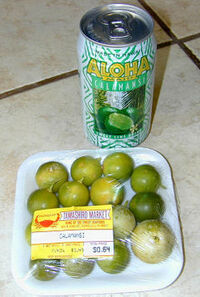
Kalamansi
Name Variations[]
- calamansi lime
- calamondin
- calamondin orange
- China orange
- Panama orange
- Kalamansi
- kalamansi lime
- musk lime
- musklime
About Kalamansi[]
Wikipedia Article About Kalamansi on Wikipedia
Kalamansi (Calamondin) or Calamansi X Citrofortunella microcarpa is a fruit tree in the family Rutaceae and a member of citrofortunella that was developed in and is very popular throughout Southeast Asia, especially the Philippines, where it is most commonly used for cooking. In the west it is variously known as acid orange, calamondin orange, or Panama orange. In the Pacific islands it is called calamansi. It is a shrub or small tree growing to 3-6 m, and bears small citrus fruit used to flavour foods and drinks. Although sometimes described as a native of the Philippines or other SE Asia areas, the tree is in fact the result of a hybrid between species in the genera citrofortunella and unknown in the wild. Hybrids between Citrus spp. have been cultivated for so long that the origins of most are obscure. It is generally held that most species in cultivation are ancient apomictic hybrids and selected cultivars of these hybrids, including crosses with other genera such as Fortunella and Poncirus. The calamondin is usually described as a cross between Citrus reticulata (tangerine or Mandarin orange) and Fortunella margarita (kumquat).
The fruit of the calamondin resembles a small, round lime, a little bigger than the size of a thumbnail, 25-35 mm in diameter. It has the inviting odor of a tangerine with a very thin orange skin. In spite of its appearance and aroma, the taste is quite sour. However, the fruit can be frozen whole and used as ice cubes in beverages like tea or ginger ale. The juice extracted by crushing the whole fruit makes a flavorful drink similar to lemonade. In Asia the juice is used to baste fish, fowl, and pork. Calamondin marmalade is made in the same way as orange marmalade—with a bit more sugar, providing a delicious spread for toast at breakfast. Like other citrus fruits, the calamansi is high in vitamin C, and the juice can be a good vitamin source.
In North America the calamondin is grown mainly as an ornamental plant; it can be especially attractive when the fruit are present. It is frost sensitive and therefore limited to warm climates (e.g., Florida, south Texas, and Hawaii in the U.S.).
Calamondin, a local citrus fruit in the Philippines and China, is cultivated in Southeast Asia as a significant crop. In the America and Europe, calamondin is grown mostly as a wonderful decorative. The tree, which is frequently qualified as a bonsai, will come into flower constant; filling the air with the perfume of citrus flower. Flower and fruit regularly will become visible at the same time. It is said that it is an acid citrus, a group that includes lemons and limes. The flesh is orange, juicy and bitter, with an excellent lime-orange savor. The little seeds are not many, with characteristic green cotyledons. The fruit, when ripe, is very sour when first tasted but if is picked earlier has a bitter taste. Calamondin halves may be served with iced tea, seafood and meats, to be squeezed for the sour liquid. They were frequently used in Florida before limes become abundant. Some people prepare the sliced fruits with cranberries to make a tart sauce. Calamondins are as well conserved whole in sugar syrup, or made into sweet pickles, or marmalade and the fruits are used to make a superior marmalade by using equal quantities of calamondins and kumquats. Calamondin fruits, fried in coconut oil with various seasonings, are eaten with curry and vegetables.
Kalamansi Recipes[]
Source[]
- Calamondin The Miniature Orange
